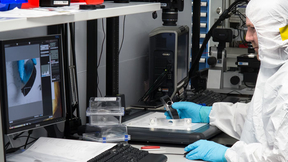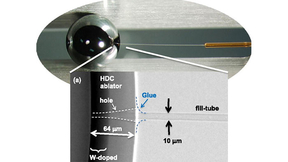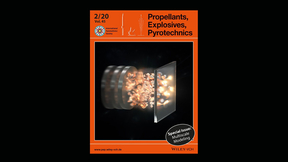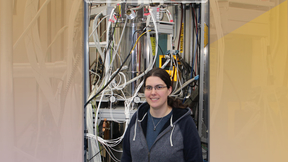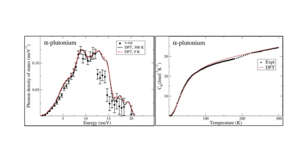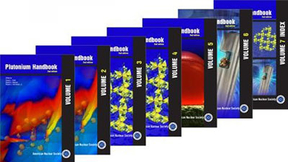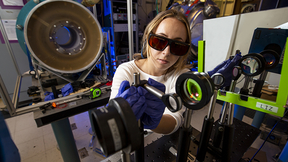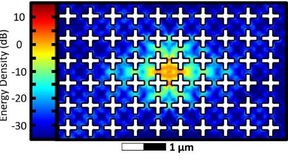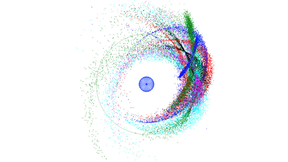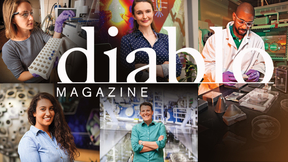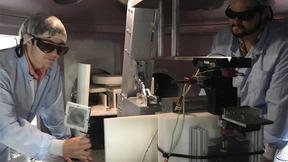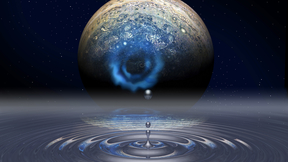Back
A paper describing the design and performance of a workhorse NIF experimental platform known as TARDIS was a featured article in a recent edition of the journal Review of Scientific Instruments.
The tiny fill-tube used to inject NIF’s high-density carbon capsules with cryogenic fuel is also known to reduce the performance of implosions, and LLNL researchers are exploring several methods that could diminish these negative effects.
A special issue of the journal Propellants, Explosives, Pyrotechnics was recently released that highlights multiscale modeling and experiments, an area of energetic materials science and technology in which LLNL researchers have played a leading role for some time. The issue features the work of MSD’s Keo Springer, Will Bassett, Sorin Bastea, Svjetlana Stekovic,…
When scientists saw the results from the first-ever Discovery Science experiment on the National Ignition Facility’s (NIF) Advanced Radiographic Capability (ARC) laser, they were genuinely surprised: The experiment produced much higher energy electrons than predicted based on the laser energy and power used on these shots. Those results, which were not typical of new…
Lawrence Livermore National Laboratory (LLNL) physicist Natalie Hell has been awarded the 2020 Dissertation Prize from the Laboratory Astrophysics Division (LAD) of the American Astronomical Society (AAS). Hell received the prize for her outstanding experimental doctoral dissertation in laboratory astrophysics. Her thesis, “Benchmarking Transition Energies and Emission…
Lawrence Livermore National Laboratory (LLNL) scientists have employed compound parabolic targets to achieve relativistic effects associated with significantly greater laser intensities. This innovation has substantially expanded the experimental capabilities of the National Ignition Facility’s (NIF) Advanced Radiographic Capability (ARC) laser. The targets, called…
Lattice vibrations (phonons) are important for all equation-of-state modeling. A recent paper by PLS researchers Per Söderlind and Lin Yang (both PHYS) describes results from the first-ever calculation of α-plutonium phonon density of states. The first-principles model agrees very well with the results of x-ray scattering experiments. Further, the calculated specific heat…
This fall, the American Nuclear Society is publishing the second edition of the Plutonium Handbook, a 4000-page, 7-volume compendium that delivers a comprehensive review of plutonium chemistry. (The first edition was published 50 years ago.) Five years in the making, this publication includes contributions from 17 Lawrence Livermore researchers, two of whom are also on the…
In high school, Liz Grace thought physics was boring and instead considered studying psychology or music. But then a college professor inspired Grace to see the wonders of physics. Today, as a National Ignition Facility (NIF) & Photon Science Summer Scholar, she’s helping to design and build a diagnostic instrument that could become a revolutionary measurement tool for…
Approximately 1000 students came to the Laboratory this summer to engage in work-study employment in science, technology, engineering, mathematics, and administrative fields. PLS hosted a number of these students through its summer student programs (described below). Nuclear science and security The Glenn T. Seaborg Institute hosted 12 students this summer, including 8…
In an ideal superconducting quantum computer, the underlying quantum bits (qubits) are isolated from the noisy environment with no energy loss to mechanical or vibrational modes. However, in the real world, amorphous materials and material interfaces have defect states that cause qubits to lose their energy through vibrations and interactions with the surrounding…
Astrophysics is a growth area in the Laboratory’s advancement of basic science for national and global security needs. In this field, data science helps researchers catalog and interpret objects orbiting Earth and process huge volumes of data captured by ground- and space-based telescopes.
When an electron encounters a laser pulse, it “wiggles” and radiates electromagnetic waves. As simple as this may sound, scientists have long struggled with an unresolved question: is the radiation energy provided by the laser or the electron? At low laser intensity, it has been experimentally confirmed that the radiation energy is entirely provided by the laser, while at…
Multilayer interference mirrors are enabling components in x-ray optical systems. These mirrors consist of periodic or non-periodic structures of alternating thin film layers of two or more materials deposited on an optical substrate. Today’s applications and experimental facilities (including the National Ignition Facility) require novel, multilayer-based hard x-ray…
Controlling nuclear fusion for power production is expected to require large and expensive magnetic coils or laser systems to create, heat, confine, and control the hot plasma needed to sustain fusion reactions. The idea of directly driving a column of plasma with an electrical discharge, known as Z pinch, was a simple and early method envisioned as a possible path to…
Typically, superlattices—faceted crystals composed of nanocrystal building blocks—have been made using slow evaporative techniques that often take days to weeks to form highly crystalline solids. This process is difficult to control, which has made it hard to systematically tune film properties and has hindered quantitative study of the assembly process. To overcome these…
Five Lawrence Livermore National Laboratory (LLNL) researchers join an eclectic group of entrepreneurs, writers, executives, philanthropists and more on Diablo Magazine’s annual "40 Under 40" list, which recognizes young professionals in the East Bay who are leading the charge in their fields. Louisa Pickworth, an experimental physicist and group leader in the Physics…
The moment Louisa Pickworth saw the rings of Saturn through her father’s backyard telescope, she knew she wanted to become a scientist to learn "more and more and more." Today, Pickworth, 32, is one of LLNL’s heralded young physicists for her work developing cutting-edge X-ray diagnostics to help scientists learn more about ultrahigh energy physics and inertial confinement…
A group of NIF & Photon Science summer scholars and visiting graduate students are experiencing the value of teamwork as they conduct experiments at LLNL’s Jupiter Laser Facility (JLF). Jesus Hinojosa, 26, a University of Michigan graduate student, and Matthew Thibodeau, 21, a Rice University undergraduate, joined a team of veteran scientists and researchers to explore…
Swirling dense metallic hydrogen dominates the interiors of Jupiter, Saturn and many extra-solar planets. Building precise models of these giant planets requires an accurate description of the transition of pressurized hydrogen into this metallic substance — a long-standing scientific challenge. In a paper published today by Science, a research team led by scientists at…

